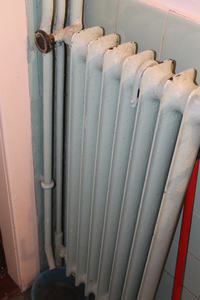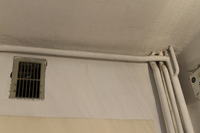Hello,
I have a problem with the installation of what is at my home. Some radiators do not heat me up. The installation is not a new open gravity type. It is several dozen years old. Recently, I replaced the stove with a new one because the old one was already growing inside. I drew an approximate diagram of this installation:

Radiators that heat are marked in red, and those that are cold are marked in blue. The new furnace is a CO boiler with a water grate SOLEI EKO-KWR 15 KW ELEKTROMET. I am also sending a photo of connecting the stove to the installation:

I have no idea why these two heaters are not working. Certainly all the valves on the radiators are open, because after installing the stove and the first start-up, the upper parts of both radiators were barely lukewarm, then they stopped heating. I regularly allowed water to be installed once every 3 weeks for the so-called "trick". Previously, they also did not heat up with the old stove. The radiators are quite old, all cast iron. I am also sending the look of the radiator of one of the two that does not work together with the end of the overflow pipe and the photo above it of the pipes that enter the attic to the expansion tank and the pipe that goes to the other non-working radiator:


In case of doubt, I can send more photos or explain the unclear ones.
I am asking for help, because another winter is coming, and I would like the bathroom to be finally warm.
Regards Macros1111
I have a problem with the installation of what is at my home. Some radiators do not heat me up. The installation is not a new open gravity type. It is several dozen years old. Recently, I replaced the stove with a new one because the old one was already growing inside. I drew an approximate diagram of this installation:

Radiators that heat are marked in red, and those that are cold are marked in blue. The new furnace is a CO boiler with a water grate SOLEI EKO-KWR 15 KW ELEKTROMET. I am also sending a photo of connecting the stove to the installation:

I have no idea why these two heaters are not working. Certainly all the valves on the radiators are open, because after installing the stove and the first start-up, the upper parts of both radiators were barely lukewarm, then they stopped heating. I regularly allowed water to be installed once every 3 weeks for the so-called "trick". Previously, they also did not heat up with the old stove. The radiators are quite old, all cast iron. I am also sending the look of the radiator of one of the two that does not work together with the end of the overflow pipe and the photo above it of the pipes that enter the attic to the expansion tank and the pipe that goes to the other non-working radiator:


In case of doubt, I can send more photos or explain the unclear ones.
I am asking for help, because another winter is coming, and I would like the bathroom to be finally warm.
Regards Macros1111



